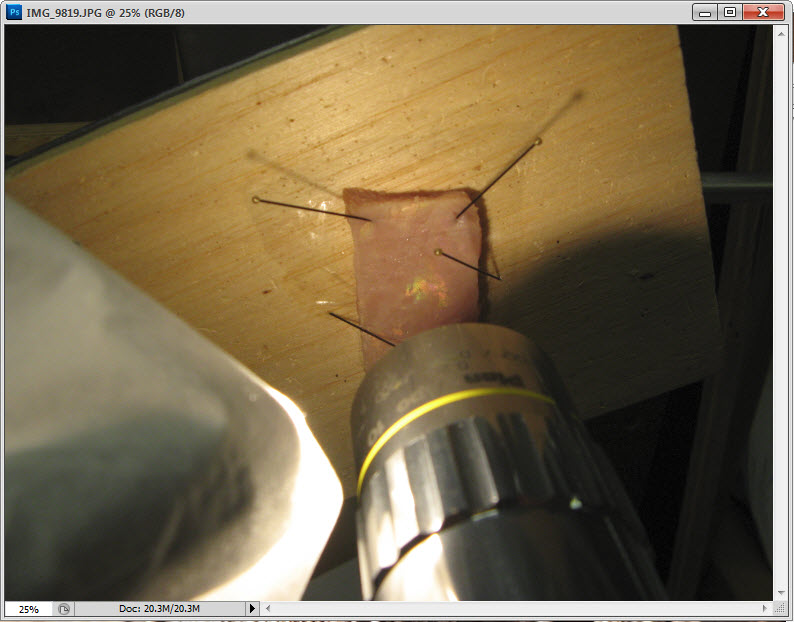Unexpected colors
Moderators: rjlittlefield, ChrisR, Chris S., Pau
I agree with ChrisR, these seem muscle in transversal section, but the interference colors...My be dried ham or may be dried tuna (here in Spain "mojama" is a salted dried tuna very apreciated -and fairly expensive- ad it shows interference colors when recent cut ...ummm), but tuna isn't pig related 
Pau
- Craig Gerard
- Posts: 2877
- Joined: Sat May 01, 2010 1:51 am
- Location: Australia
- rjlittlefield
- Site Admin
- Posts: 23626
- Joined: Tue Aug 01, 2006 8:34 am
- Location: Richland, Washington State, USA
- Contact:
And the community comes through again! 


What's imaged in this thread is an ordinary piece of ham. It was bought as precooked, ready to eat, then sliced by hand with a sharp kitchen knife.
Here's the overview and then a closer crop. The slice of meat is pinned in place over a piece of plastic wrap, with a drop of glycerin and cover glass pressed to the surface with a couple more pins.


The internet is loaded with discussions about these colors. A bunch of different explanations are offered, but the analysis I like best is the one at Structural colored meat. This was done by a graduate student in Material Science at University of Rochester as part of an imaging class, OPT307 Practical Scanning Electron Microscopy and Advanced Topics. The site says:
Hope you had as much fun with this as I did!
--Rik
What's imaged in this thread is an ordinary piece of ham. It was bought as precooked, ready to eat, then sliced by hand with a sharp kitchen knife.
Here's the overview and then a closer crop. The slice of meat is pinned in place over a piece of plastic wrap, with a drop of glycerin and cover glass pressed to the surface with a couple more pins.


The internet is loaded with discussions about these colors. A bunch of different explanations are offered, but the analysis I like best is the one at Structural colored meat. This was done by a graduate student in Material Science at University of Rochester as part of an imaging class, OPT307 Practical Scanning Electron Microscopy and Advanced Topics. The site says:
After analyzing his samples with optical microscopy, SEM, TEM, and AFM, he concludes that:Why does your ham look like this? If you google it, you will find various explanations on this color and not a single of them is supported by any experimental data! That's why I choose this as my research project.
In addition to analyzing the colored meat, the author also introduces/demonstrates a technique he calls "all-natural colorized SEM", in which a detailed image from SEM is merged automatically with color info from optical microscopy.Discussion
It was noticed that the iridescent colors always remained the same color when the sample is tilted, or rotated. The colors are most obvious when observed from the direction almost normal to the surface with top illumination. This kind of behavior is very like the result of film interference of light, instead of grating diffraction result which will usually varied in color when tilted and showing all spectrum. Also, in all-natural colorized micrographs, it was noticed that the colorful areas were always associated with film like structure. The areas with obvious grating structures only took a small portion of the whole sample surface.
Summary
Both multilayer thin film structure and 2D grating structure were observed on the cutting surfaces of ham and beef, with characteristic distance comparable with the wavelength of visible light (400-700nm). The iridescent color behaves more like the result of multilayer interference of light, correlated with the thin film like structures on meat.
Hope you had as much fun with this as I did!
--Rik
